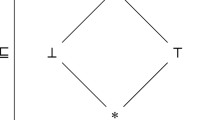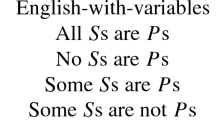Abstract
This paper considers some issues to do with valuational presentations of consequence relations, and the Galois connections between spaces of valuations and spaces of consequence relations. Some of what we present is known, and some even well-known; but much is new. The aim is a systematic overview of a range of results applicable to nonreflexive and nontransitive logics, as well as more familiar logics. We conclude by considering some connectives suggested by this approach.
Similar content being viewed by others
References
Ardeshir, M., and W. Ruitenburg, Basic propositional calculus I. Mathematical Logic Quarterly 44(3):317–343, 1998.
Arieli, O., and A. Avron, Reasoning with logical bilattices. Journal of Logic, Language and Information 5(1):25–63, 1996.
Avron, A., Natural 3-valued logics—characterization and proof theory. The Journal of Symbolic Logic 56(1):276–294, 1991.
Avron, A., The structure of interlaced bilattices. Mathematical Structures in Computer Science 6(3):287–299, 1996.
Belnap, N. D., A useful four-valued logic, in Modern Uses of Multiple-Valued Logic, D. Reidel, Dordrecht, 1977, pp. 8–37.
Białnycki-Birula, A., and H. Rasiowa, On the representation of quasi-Boolean algebras. Bulletin de l’Académie polonaise des sciences, Class III, 5:259–261, 1957.
Bimbó, K., and J. M. Dunn, Generalized Galois Logics: Relational Semantics of Nonclassical Logical Calculi. Number 188 in CSLI Lecture Notes. CSLI Publications, 2008.
Birkhoff, G., Lattice theory. American Mathematical Society, New York, 3rd edition, 1967.
Blamey, S., Partial logic, in D. M. Gabbay, and F. Guenthner, (eds.), Handbook of philosophical logic, volume 3, Springer, 1st edition, 1986, pp. 1–70.
Blamey, S., Partial logic, in D.M. Gabbay, and F. Guenthner, (eds.), Handbook of philosophical logic, volume 5, Springer, 2nd edition, 2002, pp. 261–353.
Blasio, C., J. Marcos, and H. Wansing, An Inferentially Many-Valued Two-Dimensional Notion of Entailment. Bulletin of the Section of Logic 46(3/4):233–262, 2017.
Bou, F., and U. Rivieccio, The logic of distributive bilattices. Logic Journal of the IGPL 19(1):183–216, 2011.
Caleiro, C., W. Carnielli, M. E. Coniglio, and J. Marcos, Two’s company: “The humbug of many logical values”, in J.-Y. Béziau, (ed.), Logica Universalis, Springer, 2007, pp. 175–194.
Chemla, E., P. Égré, and B. Spector, Characterizing logical consequence in many-valued logic. Journal of Logic and Computation 27:2193–2226, 2017.
Cobreros, P., Vagueness: Subvaluationism. Philosophy Compass 8(5):472–485, 2013.
Davey, B. A., and H. A. Priestley, Introduction to Lattices and Order. Cambridge University Press, Cambridge, 2002.
Dunn, J. M., Intuitive semantics for first-degree entailments and ‘coupled trees’. Philosophical Studies 29(3):149–168, 1976.
Dunn, J. M., Gaggle theory: An abstraction of Galois connections and residuation with applications to negations and various logical operators, in Logics in AI, Proceedings of European Workshop JELIA 1990, Berlin. LNCS, 1991, pp. 31–51.
Dunn, J. M., and G. M. Hardegree, Algebraic Methods in Philosophical Logic. Oxford University Press, Oxford, 2001.
Erné, M., J. Koslowski, A. Melton, and G. Strecker, A primer on Galois connections. Annals of the New York Academy of Sciences 704(1):103–125, 1993.
Fitting, M., Bilattices and the theory of truth. Journal of Philosophical Logic 18(3):225–256, 1989.
Fitting, M., Bilattices and the semantics of logic programming. Journal of Logic Programming 11(2):91–116, 1991.
Frankowski, S., Plausible reasoning expressed by p-consequence. Bulletin of the Section of Logic 37(3-4):161–170, 2008.
Frankowski, S., On the lattice of p-consequences. Reports on Mathematical Logic 45:23–35, 2010.
French, R., Structural reflexivity and the paradoxes of self-reference. Ergo 3(5):113–131, 2016.
French, R., and D. Ripley, Two Traditions. Manuscript, 2018.
Ginsberg, M. L., Multivalued logics: A uniform approach to reasoning in artificial intelligence. Computational Intelligence 4(3):265–316, 1988.
Girard, J., Proof Theory and Logical Complexity, volume I. Bibliopolis, Napoli, 1987.
Goldblatt, R., Semantic analysis of orthologic. Journal of Philosophical Logic 3:19–35, 1974.
Hardegree, G. M., Completeness and super-valuations. Journal of Philosophical Logic 34(1):81–95, 2005.
Hösli, B., and G. Jäger, About some symmetries of negation. Journal of Symbolic Logic 59(2):473–485, 1994.
Humberstone, L., Heterogeneous logic. Erkenntnis 29:395–435, 1988.
Humberstone, L., Classes of valuations closed under operations Galois-dual to Boolean sentence connectives. Publications of the Research Institute for Mathematical Sciences 32(1):9–84, 1996.
Humberstone, L., The Connectives. MIT Press, Cambridge, Massachusetts, 2012.
Humberstone, L., Sentence connectives in formal logic, in E. N. Zalta, (eds.), The Stanford Encyclopedia of Philosophy. Metaphysics Research Lab, Stanford University, winter 2016 edition, 2016.
Loparić, A., and N. C. A. da Costa, Paraconsistency, paracompleteness, and valuations. Logique et Analyse 27(106):119–131, 1984.
Malinowski, G., Q-consequence operation. Reports on Mathematical Logic 24:49–59, 1990.
Malinowski, G., Inferential many-valuedness, in J. Woleński, (ed.), Philosophical logic in Poland, Springer, 1994, pp. 75–84.
Muskens, R., Meaning and Partiality. CSLI Publications, 1995.
Ore, O., Galois Connexions. Transactions of the American Mathematical Society 55:493–513, 1944.
Priest, G., An Introduction to Non-Classical Logic: From If to Is. Cambridge University Press, Cambridge, 2nd edition, 2008.
Rasiowa, H., An Algebraic Approach to Non-Classical Logics, volume 78 of Studies in Logic and the Foundations of Mathematics. North-Holland, Amsterdam, 1974.
Restall, G., Negation in relevant logics: How I stopped worrying and learned to love the Routley star, in D. Gabbay, and H. Wansing, (eds.), What is Negation?, Kluwer Academic Publishers, Dordrecht, The Netherlands, 1999, pp. 53–76.
Ripley, D., Paradoxes and failures of cut. Australasian Journal of Philosophy 91(1):139–164, 2013.
Ripley, D., Revising up: Strengthening classical logic in the face of paradox. Philosophers’ Imprint 13(5):1–13, 2013.
Ripley, D., Blurring: An approach to conflation. Notre Dame Journal of Formal Logic 59:171–188, 2018.
Ripley, D., On the ‘transitivity’ of consequence relations. Journal of Logic and Computation 28:433–450, 2018.
Scott, D., Background to formalization, in H. Leblanc, (ed.), Truth, Syntax, and Modality. North-Holland Publishing Company, Amsterdam, 1973, pp. 244–273.
Scott, D., Completeness and axiomatizability in many-valued logic, in L. Henkin, (ed.), Proceedings of the Tarski Symposium, American Mathematical Society, Providence, Rhode Island, 1974, pp. 411–436.
Shoesmith, D. J., and T. J. Smiley, Multiple-conclusion Logic. Cambridge University Press, Cambridge, 1978.
Shramko, Y., and H. Wansing, Hyper-contradictions, generalized truth values, and logics of truth and falsehood. Journal of Logic, Language, and Information 15(4):403–424, 2006.
Shramko, Y., and H. Wansing, Entailment relations and/as truth values. Bulletin of the Section of Logic 36:131–143, 2007.
Shramko, Y., and H. Wansing, Truth and Falsehood: An Inquiry into Generalized Logical Values, volume 36 of Trends in Logic. Springer, 2011.
Suszko, R., The Fregean axiom and Polish mathematical logic in the 1920’s. Studia Logica 36(4):377–380, 1977.
Tsuji, M., Many-valued logics and Suszko’s Thesis revisited. Studia Logica 60(2):299–309, 1998.
Wansing, H., and Y. Shramko, Suszko’s Thesis, inferential many-valuedness, and the notion of a logical system. Studia Logica 88(3):405–429, 2008.
Wansing, H., and Y. Shramko, Erratum to ‘Suszko’s Thesis, Inferential Many-valuedness, and the Notion of a Logical System Studia Logica, 88:405–429, 2008’. Studia Logica 89:147, 2008.
Wójcicki, R., Theory of logical calculi. Springer Science & Business Media, 1988.
Acknowledgements
The authors would like to thank the Melbourne Logic Group, and two anonymous referees for helpful discussion and comments on this material. This research was partially supported by “Logic and Substructurality”, grant number FFI2017-84805-P, from the Ministerio de Economía, Industria y Competitividad, Government of Spain.
Author information
Authors and Affiliations
Corresponding author
Additional information
Presented by Heinrich Wansing
Rights and permissions
About this article
Cite this article
French, R., Ripley, D. Valuations: Bi, Tri, and Tetra. Stud Logica 107, 1313–1346 (2019). https://doi.org/10.1007/s11225-018-9837-1
Received:
Published:
Issue Date:
DOI: https://doi.org/10.1007/s11225-018-9837-1




